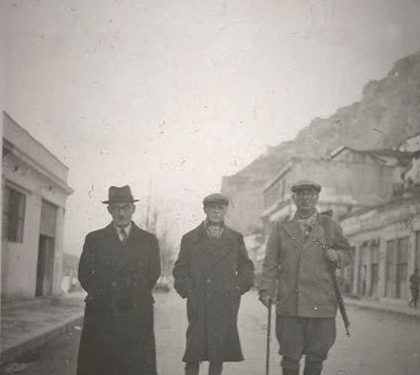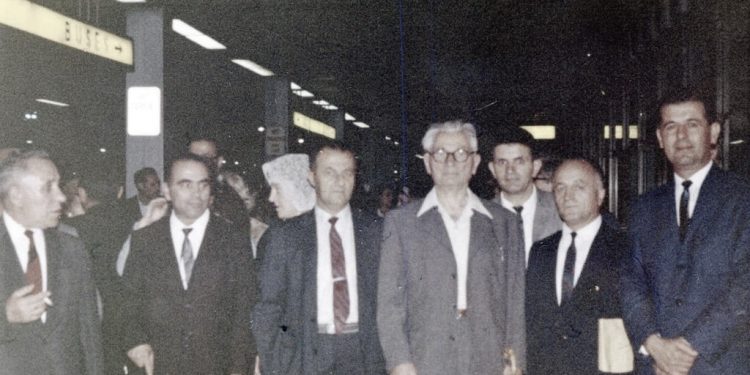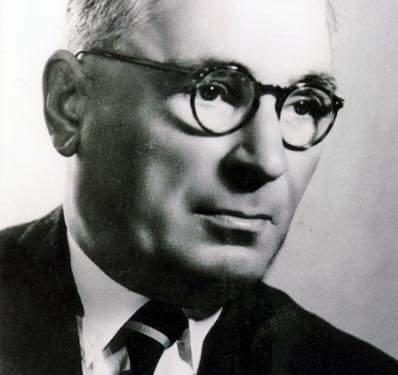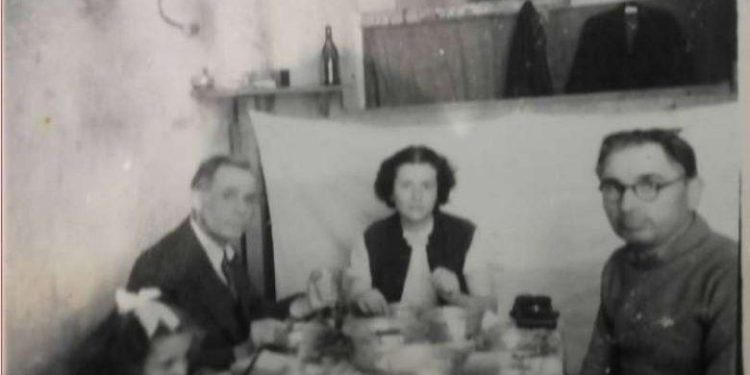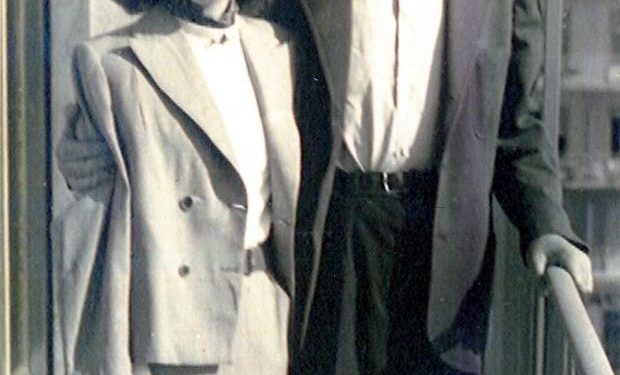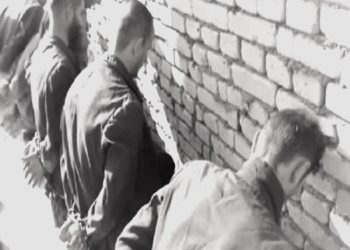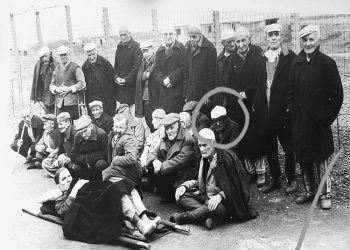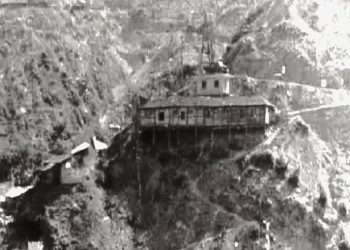Memorie.al / Sarajet Këlcyra, mostly called that during the Ottoman Empire, their entire history, they really had that of a castle. This way of existence was given by the special geostrategic location. It was this function that shaped its seven-century history and not the family that took it over and then rebuilt it. These, the inhabitants and at the same time its owners, with grace or against, were forced to live up to the military role of the position. Otherwise, geostrategy itself, and not their personal luck, got rid of them. Because they possessed unusual superiority, to control the entire surrounding area, even to be the entrance gate, from the north, of any attacker who wanted to march towards the southern lands of the Albanians, or the entrance gate, from the south, all aggressors who taught from the last years of the Balkans, or further, the Greek military burned it in 1914.
In the meantime, we reiterate: both the relief and the strange castle, on top of the mountains, have exerted a great influence on the politician Ali Këlcyra. In 1272, the gorge of Këlcyra, Klissura, as written by all the maps and documents of the time, was revived by the reappearance of a castle with dimensions sufficient to hold a small Byzantine garrison, which protected the key passage. In the old foundations there were, according to the statements, traces of Venetian construction. After fierce fighting in those stubborn provinces, the Turks took control of the key fortress after fifty years.
And this castle, now Ottoman, in the founding history of this new moment, of its destiny, has a semi-legend, which seems quite reliable. From the fighting with the Turks, all the defenders of the castle, including its commander, a follower of the old family with the name of the place, lost their lives. Only one woman remained the commander’s wife. According to the legend, in order to face the Ottomans, he also collaborated with Skenderbeu. So after that for the Turks, it was quite undesirable. The Filikate woman had a small son, quite a minor. His name was Theodore, and like his mother and father, who were no longer alive, he was a Christian. The Turks asked to send him to the school of Janissaries near the Sultan, but his mother begged him with tears in her eyes, and even fell on her knees, to let him go. He was an only child.
The Turks did not accept. A Christian and anti-Ottoman man, as the resistance of the fortress of Këlcyra had proven, could not be left in that superior, geostrategic place. But they were cunning. They pretended to open a path for him. She was told that there was a solution to her plight: that mother could keep her son at home if she married him. “I do everything, but I can’t do this”, she replied bluntly and very shocked. Thus, her little Teodori went to Istanbul, to the school of the Janissaries, and there he became Jacob. With Jakupi, the new period, the Ottoman one, of the Këlcyra dynasty began.
Hana Klissura, the new founder of her family, heard this story from her mother. Avdije Dudushi Hanëm Vrioni, has confirmed that they had bought her in Turkey, when she was a newly engaged girl with Ali Këlcyra, a book about Albania. Among other things, there was talk about this Theodore, transformed into Jacob. As far as his mother told him, in this Turkish book, there was also the coat of arms of the Këlcyra family, as well as a genealogical tree of it. She had seen that from Jacob, twelve generations had flowed. All of them were exchanged with each other, without leaving their castle on the mountain.
What is written about the palace-castle?
Gryka e Këlcyra, according to the “Albanian Encyclopedic Dictionary” of 2008, is a: “River gorge several hundred meters deep and 13 kilometers long, in the middle flow of the Vjosa between Këlcyra and Dragot, through which the Përmet highway passes – Tepelena. It has the appearance of a very deep and narrow canyon, with almost vertical slopes.” The explanation also says that the river, over millions of years, has split and split the mountains. It is also noted that; “In Gryka e Këlcyra, Vjosa receives many underground resources”.
According to Professor Skënder Muçaj, about this castle: “We inherit interesting data from the trip of U. M. Lik, on October 16, 1805. Lik also writes about the conquest of the Këlcyra fortress by Ali Pasha, during his visit to Tepelenë, on December 28, 1804: “Eight years ago, Ali took Këlcyra into his hands, killing his wife’s grandson, the bey, together with his younger brother, when he had lured them to Ioannina, to be present at the son’s wedding his, Veliu. With this action, Ali cleared the claimants for Këlcyra, a very important point, which secures Tepelena and Përmet, opens the way to Berat”.
Archaeologist Muçaj also notes that; Lik pointed out that halfway between the castle and the river, there is a palace built recently by Ali Pasha. The researcher also highlights another source of information: “This data of Liku is completed by the heiress of the Këlcyra family, Mrs. Hëna Këlcyra, through memories transmitted from one generation to another, within the family. According to her, the Këlcyra family, before the conquest of the castle by Ali Pasha Tepelena, lived in the palaces located inside the medieval castle.
The family members who escaped the massacre of Ali moved to Konya, Turkey. Hejbetullaja (Shanisha’s daughter, Ali’s sister), together with her two sons, after Ali’s murder, returned from exile and asked the Turkish authorities to live in the family palace, but they did not accept that the castle, served the army and had an important strategic position. After that, she took the palaces built in the time of Ali, under the castle, and immediately began construction, for their expansion, completing them after a few years. Hejbetullaja forced all the inhabitants of the village, who had their apartments above the saraje, to move and killed every villager who did not want to leave”.
The life of over two hundred people, inside the palaces
In this relief, which changes and transforms rapidly, just like in the mouth of a volcano, which was quite characteristic and not common, the placement in the vicinity of the centuries-old Këlcyra family’s saraj? The complex of strong and circular buildings, of a thick defensive wall, placed very high, five or six hundred meters above sea level, looked like the lord of the earth and the sky.
Filled with the inhabitants of the dynasty and their assistants, that castle tower, which was made only for defensive war. From there, no one was attacked. In the fort, there were always up to two hundred local warriors, all well-armed and dressed in Albanian dress. They lived in the castle, they were volunteers. They were fed and trained there, but not paid. They did not want this kind of relationship. They were convinced that their lives, more than the Këlcyra family, were devoted to the homeland, at that delicate point, from where, if it was crossed, it would go towards Shkumbin and the entire native lands.
They were volunteers, wholeheartedly. Often, they had come to the castle of Këlcyraj, quite young, just out of stature, but they were not janissaries, as was the model of the Ottoman Empire. This battalion was the permanent garrison of the fortress-saraj. As a castle inhabited by many people, it was supplied with abundant water, not only from springs, which were numerous around, but also from the river itself, which flowed blue below it, at the foot of the mountain. The supply road from the bayanas, where the guards of the volunteer garrison were constantly patrolling, went down to a square on its edge.
But this strange castle, which was far from the copy of Top Kapia in Istanbul, the sultan’s palace, also contained many rooms of its own, a limb of its own, a building, called the harem. This, part of the inner life of the Këlcyra saraj, resembled at first glance, an imitation of the life of the Sultan’s Court, but in reality, there was nothing like it.
The Harem of the Horses, which was the environment where the women who had no blood relation to the dynasty, but without a doubt, felt devotion to them. They came there since they were small, often brought by their parents themselves, due to the impossibility of supporting them with bread. In the saraje, they performed various services. The day’s work was led by elderly women who had also grown up there.
The women of the harem did not receive any payment, except for the women who performed the work of the cook. When they turned twenty years old and wanted to escape from the palace-castle, that is, they liked to get married and create a family of their own; the dynasty afforded them the necessary expenses of the ceremony, including a modest dowry. Probably, most of the women of the harem did not run away from there. The castle had become their second home. They were sworn to serve the Këlcyra family, just like the volunteer fighters.
Valiant Veli Bey Kalcyra
That castle-saraj was founded and survived above all as an Albanian fortress. The most expressed crown of this basic feature of the family that Veli bey, when on November 28, 1912, went to Vlora to join the action of Ismail Qemali for the declaration of national independence. Veli bey Këlcyra has his signature on the Independence Charter.
He was the son of Hysen bey. Xelal, the father of the politician Ali Këlcyra, had a brother, with another mother, Hysen’s second wife: Shega hanêm Frashër-Vila. His first wife, Zejnepe, Hanëm Konica. Veli Riza himself did not marry. Hana Klissura, who every time she mentions him, calls him “father’s little uncle”, has stored in her imagination what Ali Këlcyra has shown her.
According to his father, this family politician, of course Ali’s predecessor, moved around the castle, when he wanted to have fun or do some gymnastics, on an Italian “Bianchi” bicycle. It was a strange sight, for that castle on the side of the mountain, just like seeing the sight of a juggler in a circus. Veli Bey, who did not live long and died in Switzerland in 1920, while he was alive, was very friendly with Syrja Bey Vlora, and even sided a lot in support of his political work,.
In addition to signing the Charter of Independence, a clearly historical trace of the Këlcyra family, Veliu would be etched in the memory of the family, but also of Albania itself, with the brave gesture he performed in 1914. At that time, called the north epirote Autonomous Government, created from the Hellenized Zagor Albanian, Zograf, went against the decisions of the Conference of Ambassadors in London, in 1913, and announced the taking under his administration of the entire South. Greek armed groups, consisting of 8070 soldiers, as well as volunteers from the island of Crete, put under violence the entire claimed territory and reached the gorge of Këlcyra, to the palace-castle. It was April.
Albania first, then my sarajes
The Zografists and all the Greek Andarts, among many forms of intimidation of the Albanians and in this case, even to rule them, carried out mass burnings of the houses of all those who did not kneel to them. In any case, it was enough for them to be Muslims, as this religious hatred encouraged the Italian military to do the same to the Orthodox. One day, Veli Bey was having lunch with his young nephew, Ali Këlcyra, when they informed him that a Greek general had come to the gates of the palace, who wanted to meet them. They accepted him and listened to him politely.
The senior Hellenic soldier, who now had his temporary residence in Gjirokastër, was proposed to sign the entry of the Këlcyra family and the territory he owned, within the borders of the government, directed by Zografi. Veli bey, flatly opposed it, without leaving him a single moment of hesitation. Then the general said that, after that, he was obliged to inform Athens. She was the one who had charged him with her mission for the day.
When the high-ranking Hellenic soldier returned to the castle of Kelcyraj, he brought with him an ultimatum from Athens. Veli Bey, the main representative of the family, was given forty-eight hours to decide whether to stick with the first decision, that of not signing the recognition of the Zografi government, or finally, to sign it. The ultimatum stated that after forty-eight hours, in case of refusal, the buildings would be burned down.
“Then, added the Greek general, we will meet again in two days!”
“There is no need, said Veli Bey, I only need four hours.” The soldier froze. “Four hours are enough for me to send my people away and you to do what Athena writes.”
Veli Bey had not left the general free for a single minute, more than two hundred and forty such. If their own people accepted the two-day, they would be mistaken for swinging. Present on this stage were all the volunteers, in Albanian dress, a total of 118 fighters. They realized that; the best defense of the homeland at that moment, in the face of that Greek military cruelty, was not the fight with weapons, but what was being carried out by their leader, Veli Bey.
Within four hours, thirty volunteer riders, dressed as always in the Albanian dress, accompanied his mother, Shega, to Korça. Thirty other riders accompanied Eminë’s sister to Elbasan. Then Veli Bey took the forty servants and every other person out of the palace. After that, it went smoothly, without even filling the full four hours.
The Greek general now had no other choice but to carry out the superior order, while trying to swallow the challenge that had just been made to him by the Albanian bey. They say that initially, in order to vent his anger, he ordered cannon to be fired against the saraj, but the memory of the locals and that of the national history, has only recorded the flames. They burned every piece of wood in the palaces, unable to break down the thick, castle-like walls. They just blacked out.
For several days, the smoke covered the valley of Këlcyra, but the castle looked even more like a monument of resistance to the foreign invaders. Hana Klissura, says that her father, in this event, the burning of the sarees, did not happen to them, because he had gone to Teqën e Sukës, for a Bektashi rite, a religion which the Këlcyrajs had chosen with great desire, among the Muslim faith. They even had a tent of their own.
He didn’t see the burning of the sarees, but Ali Këlcyra, this scene remained in his memory, stronger than if he had been present. When he then went in to see it, so burnt, but with the walls standing, it seemed to him that he could not build his life, unlike the fate of that castle: don’t give up! The oracle would already have that castle. Especially her message: Albania first. Memorie.al




